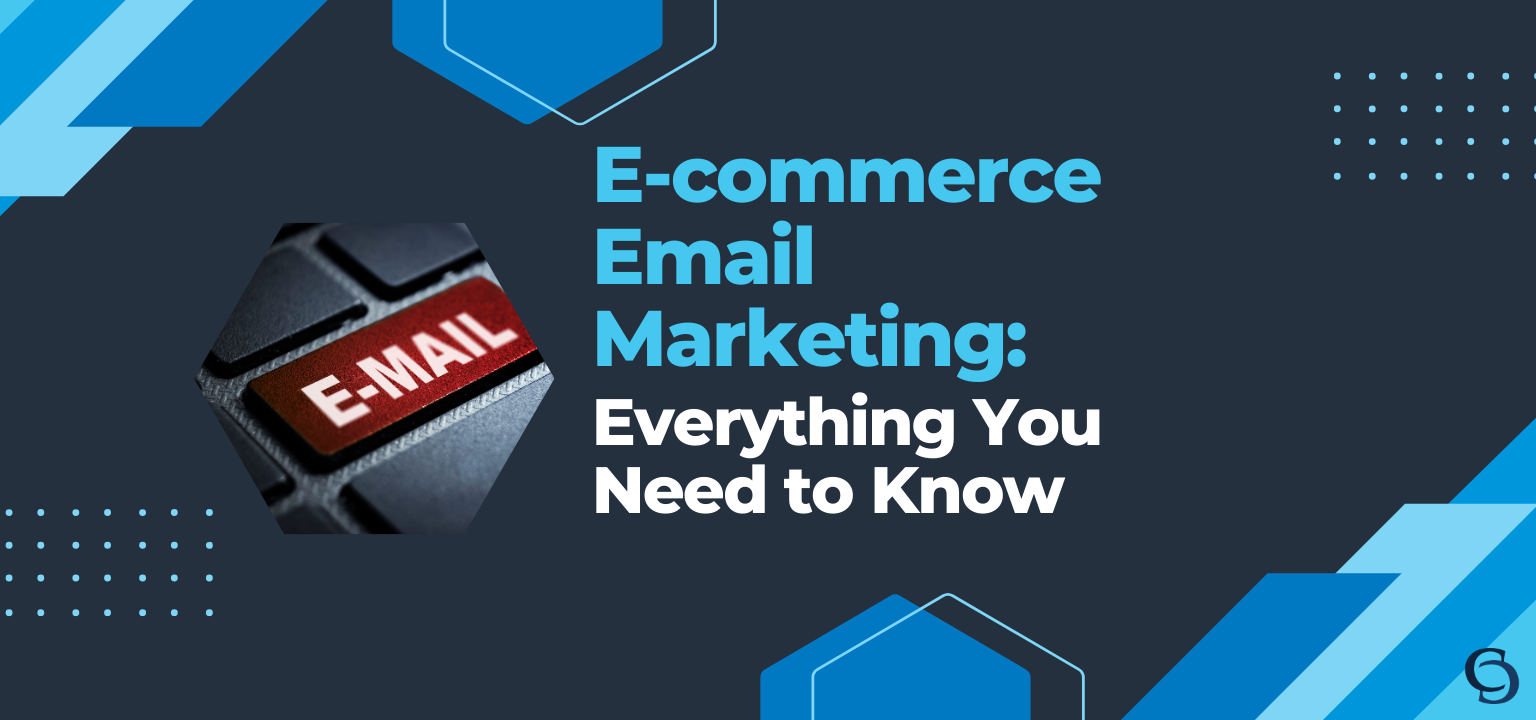E-commerce Email Marketing: Everything You Need to Know
Of all the marketing avenues open to an e-commerce brand, email marketing is the most effective. Why? Because the people you send the emails to are the one who have chosen to receive it. This makes e-commerce email marketing a more targeted way to reach your audience. Therefore, as an e-commerce brand owner, you need to familiarize yourself with the ins and outs of it. E-commerce email marketing is a science and requires a lot of moving parts to come together to be able to provide results. In this blog, we are going to study all its important aspects. By the end, you should have a working plan to get started with your e-commerce email marketing.
What is E-commerce Email Marketing?
Any and all emails you send to your existing and potential customers with the purpose of making a sale, educating and informing, or building customer loyalty is a part of your e-commerce email marketing. Emails can include any of these – welcome email, product launch, sale, retargeting, customer support, confirmation, shipping information, and more. It’s a direct one-on-one marketing channel with higher yield rates than PPC or social media campaigns. The emails you send directly influence how a customer feels about your brand. This makes e-commerce email marketing a way to establish deeper connections with your existing and potential customers.
Why Do You Need E-commerce Email Marketing?
As much as your customers may live on social media, it does not guarantee they will see your posts or ads each time. On the other hand, with e-commerce email marketing, most of the emails you send out are guaranteed to land in their inboxes. This fact itself makes email a highly effective channel for marketing. E-commerce email marketing is a fantastic way to meet customers where they are in the sales cycle. For example, when a potential customer has started exploring your brand, a personalized email can help them get acquainted or even motivate them to have a need for buying. At a closer-to-purchase stage, you can offer a discount, and so on. Essentially, this makes e-commerce email marketing a highly targeted medium, which is also why it leads to higher conversion than other marketing channels. Even after a purchase, you get to build a relationship with your customers by providing post-purchase information like styling tips, assembling instructions, etc. This helps increase customer return rate, thus keeping the acquisition cost low. Also, email is your owned marketing channel. This means that you completely own the list you build, the emails you send out, the responses you receive. So if you decide to change platforms one day, you take the list with you. Unlike social media where you’re playing in someone else’s sandbox, you can never lose the ability to engage with your subscribers due to factors like algorithm change, sudden bans, etc. This is what makes e-commerce email marketing a highly useful channel for brand owners like you.
E-commerce email marketing: Anatomy of an Effective Email
Now that we understand the importance of e-commerce email marketing, let’s focus on what makes an email effective. There are various nuances to the perfect email. The most effective email combines standard practices and personality. Let’s take a look:
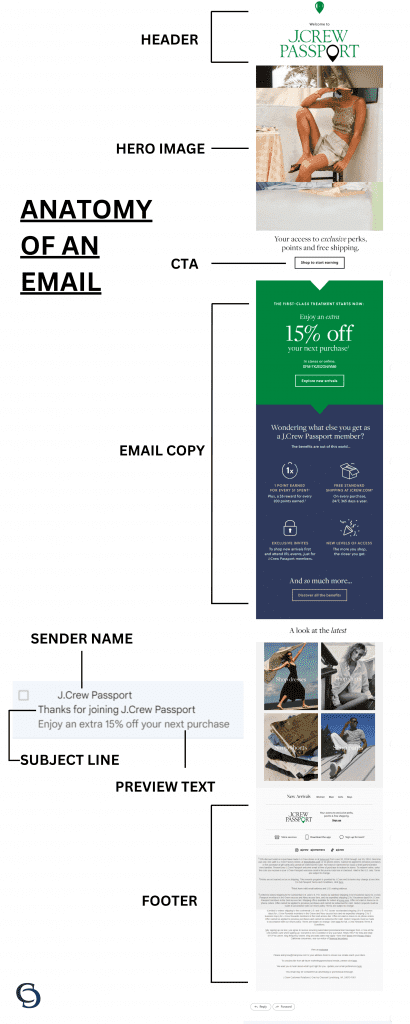 1. 3 Things That Help Decide Whether to Open an Email
1. 3 Things That Help Decide Whether to Open an Email
- Sender’s name
- Subject line
- Preview text
While optimizing the subject line and preview text, remember that most subscribers are going to view it on their mobile devices. Therefore, it’s ideal to keep the subject line below 40 characters and preview text between 30 and 80 characters. However, it’s not always possible to maintain the limit for your each of your e-commerce email marketing campaigns. In such cases, ensure that the important information stays in the visible part of the text
2. Email Copy
No one wants to read a long, text-heavy email. Frankly, no one has the time. The email content in your e-commerce email marketing campaigns should be presented in a way that is easy to scan. Here’s how to achieve that:
- Visual hierarchy using headings and varying font weights
- Text broken down into small, digestible paragraphs. A one-sentence paragraph is absolutely fine. You can also use bullet points to make the content skimmable.
- If your email does not contain images, use appropriate spacing to keep the copy readable
- Always use short sentences
The tone of your email copy should match your brand voice. This means the copy should be well personalized to your target audience persona. For example, an athletic equipment brand will have a different voice than a DIY furniture brand or a women’s apparel brand.
3. Email Purpose
Each email in your e-commerce email marketing campaign should have a singular purpose. You cannot have one email asking readers to buy a product, read a case study, and provide a survey response. If you want to sell something, do only that. If you want to solve a problem, focus only on that. Too many things overwhelm a reader. And without one single aim, readers lose interest and you end up with nothing while trying to achieve a lot of things with one email.
4. CTA
Your e-commerce marketing emails can have more than one CTA as long as you do not have too many CTAs overwhelming the user. The primary CTA should be clearly distinguishable from the rest. This can be achieved by using a large font size, button highlight, or a different colored text. Be mindful of the CTA tap area on a mobile device to ensure that other clickable items do not fall into the tap radius of the primary CTA. Clickable items should be styled differently than text. Do better than vague CTA copies like “Buy Now”, “Learn More”. Instead, be more specific “View the Product/Category” (for a new launch), “Complete Your Order”, “View Exclusive Deal”, etc.
5. Responsive Design
As already mentioned, users are more likely to open your emails on their mobile devices. Therefore the email content needs to be responsive. For effective e-commerce email marketing, any image you send should adjust according to the screen size, as should the header and footer.
6. Branding
Try to think of your e-commerce email marketing as an extension of your brand. This means your company branding should be present in your emails as it is on the website. Consistent use of your logo, brand colors, fonts, and tone of voice will reinforce your brand identity and make your emails instantly recognizable. This cohesion helps build trust and loyalty among your audience.
Email Templates for your e-commerce email marketing campaigns
1. E-commerce email marketing: Welcome Email
Welcome emails work best when you provide value upfront and set the right expectations.
Subject: Welcome to [Brand Name]! Enjoy Your Exclusive Perks Inside Hi [Customer’s First Name],
Welcome to [Brand Name]!
We’re excited to have you with us. To kick things off, here’s something special just for you:
Exclusive 20% Off Use code: WELCOME20 at checkout.
Free Shipping On your first order, no minimum purchase required.
Early Access Be the first to know about our new arrivals and exclusive sales.
Personalized Recommendations Get tailored suggestions based on your preferences.
Start exploring our latest collections and make the most of your welcome perks!
Happy shopping!
Best, The [Brand Name] Team
P.S. Need help? Our support team is here for you 24/7.
2. E-commerce email marketing: Promotional emails
You can create separate emails to notify users about upcoming seasonal promotions, once the sale is on, and a few days before the sale ends (to create urgency).
a. Seasonal discounts
Subject: Black Friday Blowout: Up to 70% Off Everything! Hi [Customer’s First Name],
The biggest sale of the year is here!
Our Black Friday Blowout starts now. Enjoy up to 70% off everything sitewide.
Top Deals:
Deal 1 Deal 2 Deal 3 Don’t miss out on these unbeatable prices. Stock is limited, so act fast!
Shop Black Friday Deals
Get ready to save big!
Best, The [Brand Name] Team
P.S. Free express shipping on orders over $75.
B. New product launch
Subject: Exciting News! Our Latest Collection Has Arrived Hi [Customer’s First Name],
We’re thrilled to introduce our latest collection!
Discover our new range of [Product Category] that blend style and functionality. Here’s what’s new:
Stylish [Product 1]: Perfect for any occasion. Innovative [Product 2]: Designed for ultimate convenience. Elegant [Product 3]: Elevate your everyday look. Be among the first to explore these fresh arrivals and add them to your collection.
Shop New Arrivals
We can’t wait for you to try them!
Best, The [Brand Name] Team
c. Price Drop on Wishlist
Subject: Surprise! Items on Your Wishlist Just Got Cheaper! Hi [Customer’s First Name],
Great news! The items on your wishlist just had a price drop!
New Lower Prices On:
[Wishlist Item 1] [Wishlist Item 2] [Wishlist Item 3] Now’s the perfect time to grab what you’ve been eyeing!
Shop Your Wishlist
Hurry, these deals won’t last long!
Best, The [Brand Name] Team
D. Referral emails
Subject: Share the Love and Earn Rewards! Hi [Customer’s First Name],
Love shopping with [Brand Name]? Share the love and get rewarded!
Refer a friend, and you both get $20 off your next purchase.
Here’s how it works:
Share your unique referral link: [Referral Link] Your friend makes their first purchase. You get $20 credit!
Refer a Friend Now
It’s a win-win for everyone!
Best, The [Brand Name] Team
e. Birthday/Anniversary
Subject: Happy Birthday, [Customer’s First Name]! Enjoy a Special Gift Hi [Customer’s First Name],
Happy Birthday from all of us at [Brand Name]!
To celebrate your special day, we’re giving you a 20% off coupon. Use code: BDAY20 at checkout.
Shop Now
Treat yourself to something special. You deserve it! Coupon expires on [Expiration Date].
Best wishes, The [Brand Name] Team
3. E-commerce email marketing: Post Purchase emails
The post-purchase experience your customer gets is very crucial in establishing how your brand is perceived. A good experience increases the chances of a second purchase manifold. Considering that customer retention rate rate is way lower than customer acquisition cost, this is where you need to pay a good amount of attention in your e-commerce email marketing campaigns. What customers need most after making a purchase is information: Where is the order? How much longer will it take to reach them? Why haven’t they received it yet? Your e-commerce email marketing should answer their questions before they have to reach out to you.
a. Order Confirmation
Subject: Great News! Your [Brand Name] Order is Confirmed Hi [Customer’s First Name],
Thank you for your order with [Brand Name]! Here are your order details:
Order Number: [Order Number] Order Date: [Order Date] Shipping Address: [Shipping Address]
Items Ordered: Item 1 Item 2 Item 3
Total Amount: [Total Amount]
Your order is confirmed, and we’re preparing it for shipment. You will receive a tracking number once your order ships.
If you have any questions or need assistance, feel free to contact us.
Thank you for shopping with us!
Best regards, The [Brand Name] Team
B. Shipping Confirmation
Subject: Your [Brand Name] Order Has Shipped! Hi [Customer’s First Name],
Great news! Your order has been shipped.
Order Number: [Order Number] Estimated Delivery Date: [Estimated Delivery Date]
Tracking Number: [Tracking Number]
You can track your package using the link below: [Tracking Link]
If you have any questions about your order, reach out to us.
Thank you for choosing [Brand Name]!
Best regards, The [Brand Name] Team
C. Shipping Delay
Subject: Important: Update on Your Order Delivery Hi [Customer’s First Name],
We wanted to let you know there’s been a delay with your order.
Order Number: [Order Number] New Estimated Delivery Date: [New Estimated Delivery Date]
We apologize for any inconvenience this may cause and are working hard to get your order to you as soon as possible.
You can still track your package using the link below: [Tracking Link]
If you have any questions or need further assistance, please don’t hesitate to contact us.
Thank you for your patience and understanding.
Best regards, The [Brand Name] Team
D. Educational
Subject: Make the Most of Your [Product Name]! Hi [Customer’s First Name],
Thank you for your recent purchase from [Brand Name]! We want to help you get the best out of your new [Product Name].
Here are some tips to get you started:
[Product Name] Styling Tips:
Mix and Match: Pair your [Product Name] with [Suggested Item] for a chic look. Accessorize: Add a [Suggested Accessory] to enhance your outfit. Care Instructions: Keep your [Product Name] looking new by [Care Tip].
We hope you enjoy your new purchase! If you have any questions or need further styling advice, feel free to reach out.
Happy styling!
Best regards, The [Brand Name] Team
E. Review request
Subject: Show Us Your [Product Name] in Action! Hi [Customer’s First Name],
We hope [Product Name] has been a great addition to your life!
Could you do us a favor? We’d love to see how you’re using [Product Name] in your daily routine. Share a review with photos, and as a token of our gratitude, we’ll send you a 10% off coupon for your next purchase.
Share Your Review: [Review Link]
Your unique perspective helps others decide, and we can’t wait to see how [Product Name] fits into your world.
Warm regards, The [Brand Name] Team
F. Subscription renewal reminder
Subject: Renew Your [Brand Name] Subscription Today! Hi [Customer’s First Name],
Just a friendly reminder that your [Brand Name] subscription is up for renewal.
Subscription Plan: [Plan Name] Ending on: [End Date] Renewal Amount: [Renewal Amount]
Renew now to continue enjoying exclusive benefits like [List Benefits].
Renew Your Subscription Now: [Renewal Link]
Thank you for being a valued subscriber. We appreciate your continued support!
Best regards, The [Brand Name] Team
G. Order Cancellation
Subject: Your [Brand Name] Order Cancellation Confirmation Hi [Customer’s First Name],
Your order has been successfully canceled.
Order Number: [Order Number] Cancellation Date: [Cancellation Date]
Any charges made will be refunded to your original payment method within [Number] business days.
If you have any questions or need further assistance, please contact us at [Customer Service Email/Phone Number].
Best regards, The [Brand Name] Team
H. Return Confirmation
Subject: Your Return Request Has Been Processed Hi [Customer’s First Name],
We wanted to inform you that we have processed your return request.
Order Number: [Order Number] Item(s) Returned:
The order amount will be refunded to your [Mode of payment] within [Number of days] days.
If you have any questions about your refund or need further assistance, please reach out to us at [Customer Service Email/Phone Number].
Best regards, The [Brand Name] Team
I. Exchange Confirmation
Subject: Your Exchange Request Has Been Processed Hi [Customer’s First Name],
We’re pleased to inform you that we have processed your exchange request.
Order Number: [Order Number] Item(s) Exchanged: Original Item: [Original Product Name] New Item: [New Product Name]
Your new item is on its way and will reach you before [Date]! We will send you an email once it has been shipped.
If you have any questions or need further assistance, please reach out to us at [Customer Service Email/Phone Number].
Thank you for shopping with us!
Best regards, The [Brand Name] Team
Recommended Read: How to Automate Customer Service
4. E-commerce email marketing: Cart Recovery emails
Customers abandon their carts for a lot of reasons. These include complicated checkout, unexpected shipping cost, mandatory account creation, lack of desirable payment options, comparison shopping, or sometimes even due to an immediate change in priority. Card recovery emails are a great way to jog their memory and even provide them a chance to ask questions about the concerns they have.
a. Customer queries
Subject: Still Interested in Your Cart? Hi [Customer’s First Name],
We noticed you left something in your cart and wanted to check in!
Items in Your Cart:
[Product Name 1] [Product Name 2] [Product Name 3] Is there anything we can help with? If you have any questions about these items or need more information to complete your purchase, please feel free to ask us.
Ask Us Anything: Simply reply to this email, and we’ll get back to you promptly.
Hope to hear from you soon!
Best regards, The [Brand Name] Team
B. Limited-time offers
Subject: Exclusive Deal: Your Cart is Now 5% Off – Act Fast! Hi [Customer’s First Name],
Guess what? Your cart price just dropped!
Unlock your savings with code: [Coupon Code] during checkout for an additional 5% off. But don’t delay – this special offer is valid for the next 12 hours only.
Complete Your Purchase Now: [Cart Link]
Seize this opportunity to make your purchase and enjoy the extra perks. If you have any questions or need further assistance, please reach out to us at [Customer Service Email/Phone Number].
Best regards, The [Brand Name] Team
5. E-commerce email marketing: Back-in-stock email
Subject: Great News! [Product Name] is Back in Stock! Hi [Customer’s First Name],
Exciting news – the [Product Name] you’ve been waiting for is back in stock! We noticed you had set up a notification for this product, and we’re happy to inform you it’s available again.
Shop Now: [Product Link]
Don’t miss your chance to get it before it sells out again!
If you have any questions or need assistance, feel free to reach out to us.
Happy shopping!
Best regards, The [Brand Name] Team
6. E-commerce email marketing: Re-Engagement/Win back Email
Subject: We Miss You! Come Back and See What’s New Hi [Customer’s First Name],
We’ve missed you at [Brand Name] and hope you’ve been well!
A lot has happened since your last visit. We’ve got exciting new products and exclusive offers just for you.
Explore What’s New: [Link to New Arrivals]
As a special welcome back, enjoy 15% off your next purchase with code: WELCOME15.
If you have any questions or need assistance, we’re here to help. Reach out anytime at [Customer Service Email/Phone Number].
We hope to see you soon!
Best regards, The [Brand Name] Team
How to Create an E-commerce Email Marketing List
If you ask an e-commerce business owner what their biggest marketing regrets are, they would tell you that they didn’t start collecting email addresses from the first day of business. So here are a few ways to avoid that mistake:
1. Use an Email Opt-in Pop-up
Pretty much every e-commerce email marketing starts with a standard opt-in pop-up. This appears a few seconds after a user lands on your website. To entice new users to sign up, you can offer a welcome discount, a giveaway, and free shipping. Some brands offer exclusive subscriber-only content like early access, helpful guides, etc. instead of discounts. In addition to the pop-up, this form should have a permanent place in the footer of your website. You can also gamify the sign-up forms. Spin the wheel is commonly used for this where users need to provide their email ID to interact.
2. Collect Emails at Checkout
Next to the welcome emails, the bulk of your email list for your e-commerce email marketing campaigns will come from your paying customers. Depending on what your customer purchases from your site, you can set up custom auto-responders. For example, you can send upsell/cross-sell emails based on the purchase, or provide post-purchase styling guides, assembly instructions, etc.
3. Interactive Tool
A product recommendation quiz is a great way to collect email addresses for your e-commerce email marketing campaigns. It provides additional value to the user in exchange for their emails. More than that, it helps in product discovery while engaging the customer as they spend more time interacting with your website. Additionally, these personalized recommendations can reduce product return rates if implemented effectively. It’s the perfect win-win. How to make it effective?
- Provide value that is worth their time and email
- Make it easy to find and use
- Promote it on social media
- Offer personalized results only
The video below shows how performance nutrition brand, Gainful has integrated their intelligent product finder tool into the user journey on their website. At the end of the QnA, Gainful asks for the email address for quiz taker.
4. Add a Signup Button on Your Social Media Page
Your brand’s social media profiles are also great places to collect emails. People want to stay in the know of the latest trends, which is why getting them to sign up will become all the more easy. Adding a ‘Sign Up’ button to Facebook is easy. However, Instagram being a less link-friendly platform, requires a little more work. You can use tools like Linktree, Linkpop, etc. to create custom landing pages with multiple links – one could lead to your website and the other to your signup form, etc. Once they are in, you can quickly pull them into more personalized email nurturing campaigns.
Best Practices for E-commerce Email Marketing
Now that you have an email list and a bunch of templates to work with, what are the next steps?
1. Choose an Email Service Provider
When selecting an Email Service Provider (ESP), consider the following:
- Security: Ensure robust data protection measures.
- Ease of Use: Look for an intuitive interface.
- Audience Segmentation: Ability to segment your audience as new subscribers, one-time buyers, cart abandoners, etc.
- Data Analytics: Access to detailed performance metrics like open, click, bounce, unsubscription rates, and so on.
- Automation: Tools for automating workflows and campaigns.
Popular ESPs include Hubspot, Klaviyo, Mailmodo, Mailchimp, Brevo, Omnisend, and ActiveCampaign. Each offers unique features, so choose one that aligns with your business needs.
2. Authenticate Your Email Domain
Authentication is a technical process. It tells mailbox providers like Google and Yahoo that your email domain is legitimate. Set up these protocols:
- DKIM (DomainKeys Identified Mail): Ensures email content integrity.
- DMARC (Domain-based Message Authentication, Reporting & Conformance): Helps prevent email spoofing.
- SPF (Sender Policy Framework): Verifies the sender’s IP address.
Authentication improves deliverability and protects your brand.
3. Compliance & Permission
Mailboxes like Google and Yahoo are strict about email spamming. To prevent unwanted emails, anti-spam regulations like CAN-SPAM and GDPR are enforced. This means you need permission to email everyone on your list. This can be achieved by providing a checkbox in your sign-up form for subscribers to give permission to receive emails.
4. Timing & Frequency
Timing and frequency of emails are critical for engagement success. Watch your metrics closely—open rates, click-through rates, and unsubscribes—to guide your strategy. For example, if sending three emails per week leads to high unsubscribes, scale back to one or two. Ensure changes are gradual to gauge effectiveness accurately and maintain subscriber engagement.
5. Include an Unsubscribe Link
According to anti-spam laws, each email must include an unsubscribe link and a physical mailing address. Ensure that the Unsubscribe link is working. Usually, most email service providers have an unsubscribe option. However, you will need to add the mailing address yourself.
6. Keep Your Email List Clean
Maintaining a clean email list is essential for maintaining a positive sender reputation and maximizing deliverability. Sending to invalid email addresses results in hard bounces and can lead to spam complaints, damaging your email reputation. If unchecked, this can cause emails to be routed to spam folders or not delivered at all. Monitor the following KPIs to prevent this:
- Bounce Rate: Regularly check for and remove invalid email addresses to minimize hard bounces.
- Open Rate: If a person hasn’t opened your email in 3 years, chances are they never will. Consider removing them to boost overall engagement metrics.
- Unsubscribe Rate: Promptly honor unsubscribe requests to maintain compliance and improve email list quality.
By proactively managing these factors, you can enhance email deliverability and engagement with your audience.
Email Flows for Your E-commerce Email Marketing Campaigns
Get started with your e-commerce email marketing campaigns with the following flows: 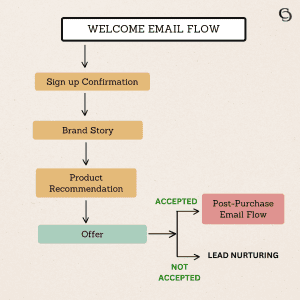
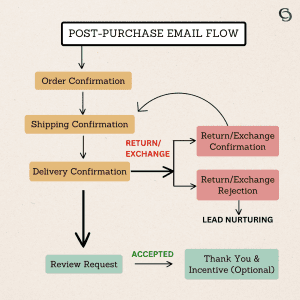

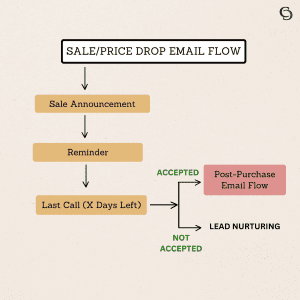
need help with your e-commerce email marketing?
We are here to help with any e-commerce email marketing requirements you might have. As experts in the field, we bring extensive experience and daily dedication to crafting successful email marketing campaigns. Whether you need assistance with creating engaging content, optimizing email design, or implementing automated workflows, our team is ready to elevate your e-commerce email marketing strategy. For any queries regarding e-commerce email marketing, reach out to us at (888) 811-3073 or support@codaemon.com.
